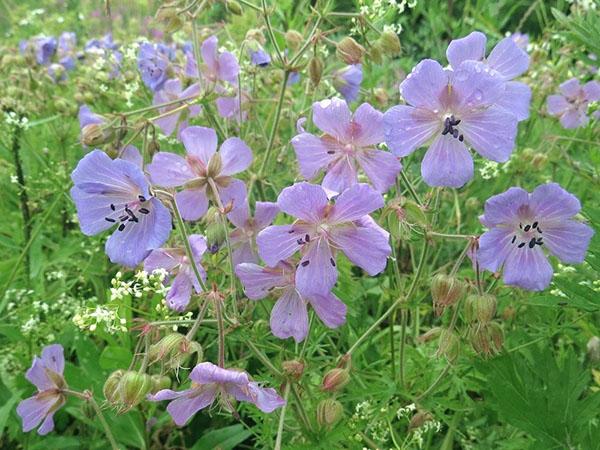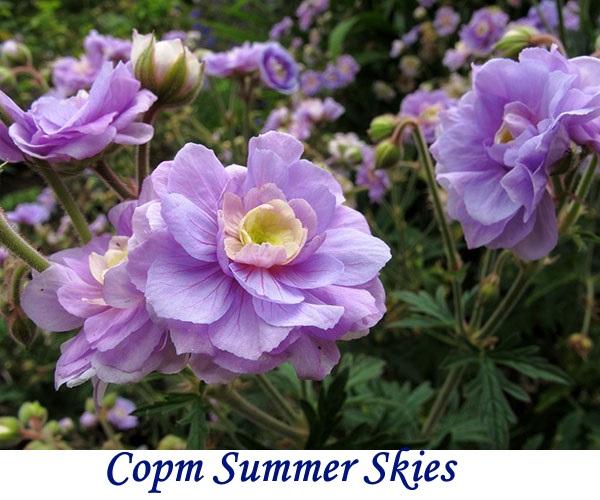What does meadow geranium look like and what is useful?
 Meadow geranium is a beautifully flowering perennial plant that grows in the wild. It has a number of medicinal properties, so it is used not only for decorative, but also for medicinal purposes.
Meadow geranium is a beautifully flowering perennial plant that grows in the wild. It has a number of medicinal properties, so it is used not only for decorative, but also for medicinal purposes.
Description of meadow geranium

The leaves and stem are covered with hairs. The leaf plate is rounded. The basal leaves are seven-partite to the base into rhombic lobes, the stem leaves are five-partite, and the upper ones are three-partite.
In June-July, meadow geranium blooms. Large, wide-open purple-blue flowers, consisting of five petals, appear on the umbrella-shaped inflorescences.
Fruits appear in August-September. They are formations in the form of a beak up to 3 cm long. Inside are seeds that can be used to propagate the plant.
The plant grows in meadows, coniferous and deciduous forests. It is also grown by gardeners in flower beds.
Geranium species
There are dozens of garden forms, but the most popular are:
- Summer Skies. This is a terry variety. The flowers are white with a pink-purple tint.

- Splish Splash. Plants are characterized by a small height, up to 50 cm, as well as a spreading bush. The flowers are white with blue streaks, up to 4 cm in diameter.

- Black Beauty. Plants are medium-sized, 40-50 cm in height. The flowers consist of 5 petals of a delicate lavender shade.

- Silver Queen. The plant of this variety is tall, up to 1.3 m in height. The flowers are large, purple.

- Double Jewel. This is a plant with double flowers of an interesting color. White petals take on a lilac hue at the base.

Medicinal properties of meadow geranium and contraindications for use
 The plant is valuable because it contains a large amount of nutrients. The basis is made up of tannins.
The plant is valuable because it contains a large amount of nutrients. The basis is made up of tannins.
It also includes:
- saponins;
- alkaloids;
- flavonoids;
- essential oils;
- anthocyanins;
- vitamins K and C;
- minerals - zinc, iron, manganese, nickel.
The root system is rich in:
- tannin;
- phenolic compounds;
- starch;
- catechins;
- phenolcarboxylic acid.
In folk medicine, the aerial part of the plant is used, and sometimes the roots. Raw materials are harvested during flowering, rhizomes are dug up in the fall.
Geranium has the following effects:
- astringent;
- hemostatic;
- anti-inflammatory;
- antipyretic;
- pain reliever;
- disinfectant;
- antimicrobial;
- antitoxic;
- wound healing;
- antipruritic;
- relaxing.
Due to its wide range of effects, the plant is used in the treatment of many diseases. But before use, you must read the list of contraindications.
The herb cannot be used in cases:
- childhood;
- gastritis, ulcer;
- thrombosis, thrombophlebitis, thromboembolism;
- intestinal obstruction, chronic constipation.
Taking a medicine based on geranium inside, it is necessary to accurately observe the dosage.
Application during pregnancy and lactation must be agreed with the attending physician. Self-medication can be harmful.
What diseases does meadow geranium cure
 This is a versatile plant for many diseases.
This is a versatile plant for many diseases.
It is taken orally to treat ailments:
- inflammatory processes of the reproductive system in women, prolonged uterine bleeding;
- imbalance of hormones;
- urolithiasis disease;
- nervous disorders, sleep disturbance;
- malignant formations;
- heart disease, in particular tachycardia and angina pectoris;
- diseases of the upper respiratory tract;
- food poisoning, intestinal infections;
- upset stool;
- gastrointestinal diseases, in particular gastritis with low acidity, enteritis.
Outwardly, drugs are used to treat purulent wounds, ulcers, fistulas, and inflammatory processes in the oral cavity. The plant reduces pain from injuries of the musculoskeletal system, helps with rheumatism and gout. It is also used to strengthen hair follicles in case of profuse hair loss.
Cultivation of meadow geranium
The plant is not picky about care, it is not susceptible to diseases and pests, but it is necessary to create favorable conditions for it. Geranium prefers a sunny location with fertile, moist soil. But it can grow in slightly shaded areas.
You can add rotted to the hole for planting a plant manure, the next few years do not need to be fertilized. Periodically, the earth around it must be loosened, removed weed... In drought, it is advisable to water, but it is impossible to overmoisten the soil, the roots can rot.
To cultivate geraniums in a flower bed for decorative purposes, it is worth taking a closer look at other varieties, for example, street or garden.